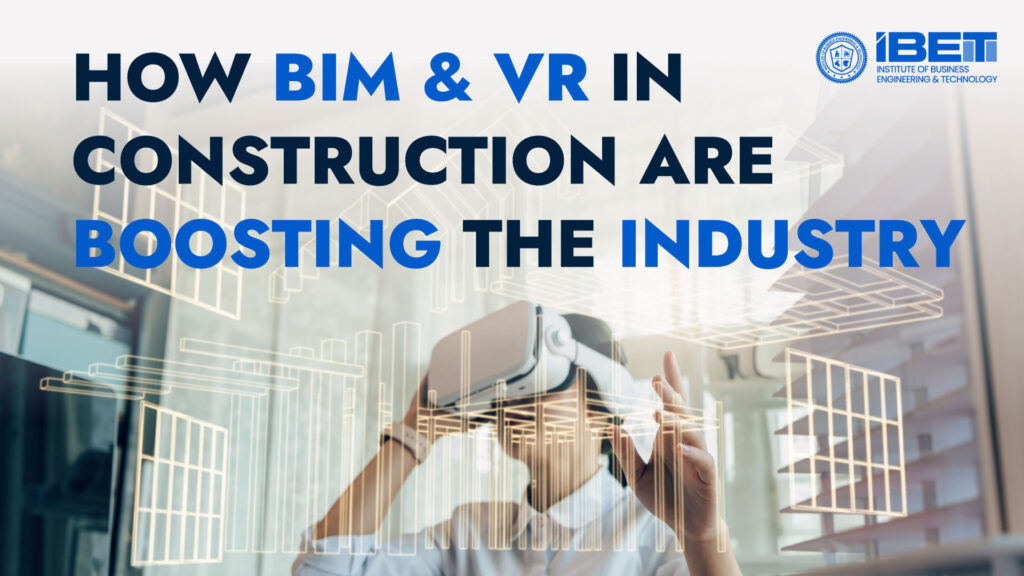The construction industry is rapidly evolving with the integration of cutting-edge technologies like Building Information Modeling (BIM) and Virtual Reality (VR). These innovations are not only enhancing efficiency but also revolutionizing the way we approach design, planning, and execution in construction projects. At IBET Learning, we offer comprehensive courses in Interior Design, Architecture, and Construction, enabling professionals to stay ahead in this dynamic field.
The Power of BIM in Construction
BIM is transforming construction by providing a digital representation of the physical and functional characteristics of a facility. This intelligent 3D model-based process gives architects, engineers, and construction professionals the insights and tools to plan, design, construct, and manage buildings and infrastructure more efficiently.
Key Benefits of BIM:
- Improved Collaboration: BIM facilitates better collaboration among project stakeholders by providing a shared environment for project data.
- Enhanced Visualization: With 3D models, teams can visualize the entire project before construction begins, identifying potential issues early.
- Cost and Time Efficiency: BIM helps in accurate cost estimation and reduces project delays by enabling effective scheduling and resource management.
- Sustainability: It promotes sustainable design by allowing the analysis of energy performance and environmental impact.
VR: Immersive Construction Planning
Virtual Reality is another game-changer in the construction industry, offering immersive experiences that traditional 2D plans or even 3D models cannot match. VR enables stakeholders to virtually walk through a project before it’s built, providing a realistic sense of space and design.
Advantages of VR in Construction:
- Enhanced Design Understanding: VR provides a realistic visualization of the project, helping clients and teams to better understand the design.
- Risk Mitigation: By experiencing the virtual model, potential design flaws can be identified and corrected before construction starts.
- Improved Client Engagement: Clients can explore and interact with the project in a virtual environment, leading to better satisfaction and informed decision-making.
- Training and Safety: VR can be used for training construction workers and ensuring safety protocols by simulating real-world scenarios.
Using VR During Cost Estimations and Planning Schedule
VR is proving to be invaluable during cost estimations and planning schedules. By creating a virtual model of the project, estimators can more accurately assess the required materials and labor, reducing the risk of over or under-budgeting. Additionally, VR helps in visualizing the construction sequence, allowing for a more detailed and efficient scheduling process.
Using VR During Coordination and Construction
During the coordination and construction phases, VR facilitates better communication and collaboration among team members. By providing a shared virtual space, all stakeholders can review the project’s progress, identify any discrepancies, and make informed decisions in real-time. This leads to a more streamlined construction process, minimizing delays and errors.
6 Benefits from Combining BIM and VR in Construction Projects
- Enhanced Visualization: Combining BIM and VR provides a comprehensive view of the project, improving design accuracy and stakeholder understanding.
- Improved Collaboration: A shared virtual environment enhances communication and coordination among project teams.
- Efficient Problem-Solving: Potential issues can be identified and addressed early, reducing costly rework.
- Accurate Cost Estimation: The integration helps in precise material and labor estimations, leading to better budget management.
- Optimized Scheduling: Virtual simulations of the construction sequence improve scheduling efficiency.
- Increased Client Satisfaction: Clients can virtually experience the project, leading to better engagement and satisfaction.
Virtual Reality Software: A Performance Lever for the Construction Business
The use of VR software is becoming a crucial performance lever for the construction business. By enabling immersive simulations and real-time collaboration, VR software enhances project planning, design, and execution. It allows construction companies to stay competitive by improving efficiency, reducing risks, and delivering higher quality projects.
Integrating BIM and VR at IBET Learning
At IBET Learning, we recognize the immense potential of BIM and VR in transforming construction practices. Our specialized courses in Interior Design, Architecture, and Construction are designed to equip professionals with the necessary skills to leverage these technologies effectively.
Why Choose IBET Learning:
- Expert-Led Courses: Learn from industry experts who bring real-world experience and insights.
- Comprehensive Curriculum: Our courses cover the latest advancements in BIM and VR, ensuring you stay updated with industry trends.
- Hands-On Training: Gain practical experience through interactive modules and real-world projects.
- Flexible Learning: Our courses are designed to fit your schedule, offering both online and on-campus options.
Boost Your Career with IBET Learning
Embrace the future of construction with BIM and VR by enrolling in our courses at IBET Learning. Stay ahead of the curve and enhance your career prospects in Interior Design, Architecture, and Construction.
For more information, visit our website and discover how our programs can help you achieve your professional goals.

